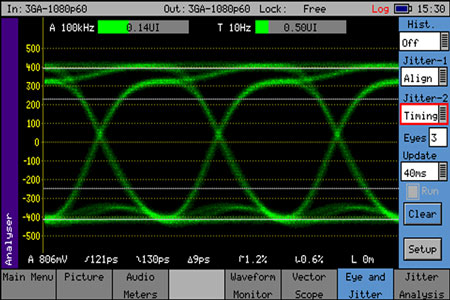Broadcast News
06/11/2019
Fibre Optic Brief

Fibre optic links have now been in use for many years in the commercial/military field, primarily in the military field for security as it does not radiate and the commercial field for its greater link spans and high data rates.
As it is now becoming increasingly used in the broadcast industry this article is intended to give an understanding of the various items and terms used.
There are many excellent articles which cover how light propagates down fibres which I shall not go into any great detail on the physics, however I will share some information which may be of interest and use.
The 'light' can be at different wave lengths dependent on materials. These can go simultaneously and independently down a single fibre so you can increase the capacity without having to put in multiple fibres. The 'light' has a wavelength of approximatively 1200 to 1600nm spacing and is usually 20nm referred to as CWDM (course wave length division multiplexing), a more expensive 10nm spacing can also be used DWDM (dense). This 'light' generation requires laser transmitters.
Some Ethernet is at 850nm which can then use LEDs and is visible.
It is also possible to transmit this in one direction at one wavelength and a different wavelength in the other 'BIDI', so you get full duplex with one fibre. An example of CWDM and BIDI is in the Volamp Camlinx camera back systems.
At one time there were a lot of different fibres and connectors used, but for the broadcast industry the most common cable Single Mode (SM), which has a core of 9 microns hair is about 70.
The data world is normally 62.5 microns Multi Mode, both fibres are 125 micron diameter external.
The attenuation down SM fibre is very low and the difference between a short cable of around 100m and 1Km will not normally be a problem - dirt or damaged ends will be far more likely to be the culprit.
The transmitters/receivers are now much more simplified and readily available as a module (SFP).
However, there is one major difference with video SFPs and data types and this is due to the coding used. The data in both cases starts off as an NRZ (non return to zero) which must be encoded for fibre or ac coupled links. Ethernet uses a coding which results in a 25% increase in data rate, which is then scrambled for copper to reduce EMC, but not scrambled for fibre. SMPTE just scrambles and this results in difficulties with certain patterns so called Pathological. Data types will error with these – for net results you have to use a video type which costs five times as much. There is negligible internal difference in the SFPs and it is put down to quantity. This is regrettable as SMPTE did not recognise this and code such as the higher rates can be implemented with data SFPs. which are readily available. WARNING: due to lack of standardization with video SFPs it is possible that a high output transmitter will overload a receiver, also the flux budget (difference between output power and sensitivity) varies from the SFP manufacturers. A different SFP at each end of the link can be a problem with overload or low flux budget. MSA (multi source agreement) ensures physical compatibility, but not optical.
2G-MSG
This note is to bring the users attention that Multi Source Agreement MSA has limitations.
Volamp has had a 12G in the 4x3G formate for some time and these were all basically 3G products on different wavelengths which are combined (multiplexed) at the transmitter and demultiplexed at the receiver.
The fibre to copper transceivers usually incorporate SFPs (Small Form-factor Plugable) - these are now becoming available at 12G.
In an effort to standardise the manufacturers of these devices agreed a common specification so that they would be interchangeable.
SFPs produced to this specification are mechanically interchangeable. SFPs with DOM/DDM (Digital Optical/Diagnostics Monitor can also be monitored for many parameters by reading from standard registers. This includes transmit wavelength, receive power, information on vendor and many more parameters.
BUT MSA have not standardised the very basic parameters of transmit power, sensitivity and overload.
From the same SFP manufacturer you can have a maximum power output which exceeds the overload specification which can cause errors. This applies to HD as well as 12G. Different manufacturers again have varying specifications. The 12G SFPs also can incorporate re-clocking.
Volamp uses SFPs which are gauranteed to have a budget of 10db and will not overload.
William Saich, Volamp
www.volamp.com
As it is now becoming increasingly used in the broadcast industry this article is intended to give an understanding of the various items and terms used.
There are many excellent articles which cover how light propagates down fibres which I shall not go into any great detail on the physics, however I will share some information which may be of interest and use.
The 'light' can be at different wave lengths dependent on materials. These can go simultaneously and independently down a single fibre so you can increase the capacity without having to put in multiple fibres. The 'light' has a wavelength of approximatively 1200 to 1600nm spacing and is usually 20nm referred to as CWDM (course wave length division multiplexing), a more expensive 10nm spacing can also be used DWDM (dense). This 'light' generation requires laser transmitters.
Some Ethernet is at 850nm which can then use LEDs and is visible.
It is also possible to transmit this in one direction at one wavelength and a different wavelength in the other 'BIDI', so you get full duplex with one fibre. An example of CWDM and BIDI is in the Volamp Camlinx camera back systems.
At one time there were a lot of different fibres and connectors used, but for the broadcast industry the most common cable Single Mode (SM), which has a core of 9 microns hair is about 70.
The data world is normally 62.5 microns Multi Mode, both fibres are 125 micron diameter external.
The attenuation down SM fibre is very low and the difference between a short cable of around 100m and 1Km will not normally be a problem - dirt or damaged ends will be far more likely to be the culprit.
The transmitters/receivers are now much more simplified and readily available as a module (SFP).
However, there is one major difference with video SFPs and data types and this is due to the coding used. The data in both cases starts off as an NRZ (non return to zero) which must be encoded for fibre or ac coupled links. Ethernet uses a coding which results in a 25% increase in data rate, which is then scrambled for copper to reduce EMC, but not scrambled for fibre. SMPTE just scrambles and this results in difficulties with certain patterns so called Pathological. Data types will error with these – for net results you have to use a video type which costs five times as much. There is negligible internal difference in the SFPs and it is put down to quantity. This is regrettable as SMPTE did not recognise this and code such as the higher rates can be implemented with data SFPs. which are readily available. WARNING: due to lack of standardization with video SFPs it is possible that a high output transmitter will overload a receiver, also the flux budget (difference between output power and sensitivity) varies from the SFP manufacturers. A different SFP at each end of the link can be a problem with overload or low flux budget. MSA (multi source agreement) ensures physical compatibility, but not optical.
2G-MSG
This note is to bring the users attention that Multi Source Agreement MSA has limitations.
Volamp has had a 12G in the 4x3G formate for some time and these were all basically 3G products on different wavelengths which are combined (multiplexed) at the transmitter and demultiplexed at the receiver.
The fibre to copper transceivers usually incorporate SFPs (Small Form-factor Plugable) - these are now becoming available at 12G.
In an effort to standardise the manufacturers of these devices agreed a common specification so that they would be interchangeable.
SFPs produced to this specification are mechanically interchangeable. SFPs with DOM/DDM (Digital Optical/Diagnostics Monitor can also be monitored for many parameters by reading from standard registers. This includes transmit wavelength, receive power, information on vendor and many more parameters.
BUT MSA have not standardised the very basic parameters of transmit power, sensitivity and overload.
From the same SFP manufacturer you can have a maximum power output which exceeds the overload specification which can cause errors. This applies to HD as well as 12G. Different manufacturers again have varying specifications. The 12G SFPs also can incorporate re-clocking.
Volamp uses SFPs which are gauranteed to have a budget of 10db and will not overload.
William Saich, Volamp
www.volamp.com
Top Related Stories
Click here for the latest broadcast news stories.
23/05/2019
Sonnet Technologies Launches Solo10G™ SFP+ PCIe Card
Sonnet Technologies has announced the Solo10G™ SFP+ PCIe Card and the Solo10G™ SFP+ Thunderbolt™ 3 Edition adapter, the latest products in the company
Sonnet Technologies Launches Solo10G™ SFP+ PCIe Card
Sonnet Technologies has announced the Solo10G™ SFP+ PCIe Card and the Solo10G™ SFP+ Thunderbolt™ 3 Edition adapter, the latest products in the company
18/03/2014
Artel Video Offers Embrionix SFP Modules
Artel Video Systems has integrated Embrionix SFP (emSFP™) solution into its DigiLink media transport platform. DigiLink with Embrionix technology will
Artel Video Offers Embrionix SFP Modules
Artel Video Systems has integrated Embrionix SFP (emSFP™) solution into its DigiLink media transport platform. DigiLink with Embrionix technology will
17/11/2009
AXON And SFP On The Move With 3D
SFP (Société Française de Production), one of the major technical facilities and service providers from France has successfully performed its first 3D
AXON And SFP On The Move With 3D
SFP (Société Française de Production), one of the major technical facilities and service providers from France has successfully performed its first 3D
18/07/2008
Thomson Cameras Help Euromedia/SFP Stay Ahead Of The Pack At The Tour De France
Outside broadcast (OB) production company Euromedia/SFP (Société Française de Production) is using Thomson Grass Valley LDK 8000 high definition camer
Thomson Cameras Help Euromedia/SFP Stay Ahead Of The Pack At The Tour De France
Outside broadcast (OB) production company Euromedia/SFP (Société Française de Production) is using Thomson Grass Valley LDK 8000 high definition camer
02/03/2009
Fibre Optics... The Past, Present And Future - Claratech Group
Although there were some discoveries in the late 19th century that were related to light and its propagation though a medium, it was not until the lat
Fibre Optics... The Past, Present And Future - Claratech Group
Although there were some discoveries in the late 19th century that were related to light and its propagation though a medium, it was not until the lat
15/08/2014
Fibre Optics In The Broadcast Industry
Over the last few decades there has been a revolution in the transmission of information with the development of fibre optical technology, writes B. M
Fibre Optics In The Broadcast Industry
Over the last few decades there has been a revolution in the transmission of information with the development of fibre optical technology, writes B. M
12/12/2016
Canford Launches Fibre Termination Service
Canford is celebrating reaching the impressive milestone of completing its 40th year in business, an achievement made possible through continuously ev
Canford Launches Fibre Termination Service
Canford is celebrating reaching the impressive milestone of completing its 40th year in business, an achievement made possible through continuously ev
30/01/2013
3M Introduces One Pass Fibre Pathway
3M, the diversified technology company, has launched its 3M One Pass Fibre Pathway range in the UK and Ireland. Addressing the growing demand for high
3M Introduces One Pass Fibre Pathway
3M, the diversified technology company, has launched its 3M One Pass Fibre Pathway range in the UK and Ireland. Addressing the growing demand for high
15/09/2003
Vistek launch expanded fibre optic range at IBC
Although several modular interface manufacturers can now offer some fibre optic interfaces, few can provide the range of products now being delivered
Vistek launch expanded fibre optic range at IBC
Although several modular interface manufacturers can now offer some fibre optic interfaces, few can provide the range of products now being delivered
20/10/2009
Argosy Adds Winchester Electronics Products
A leading UK-based international supplier of HD broadcast cables and studio infrastructure products, Argosy, has announced that it has added the award
Argosy Adds Winchester Electronics Products
A leading UK-based international supplier of HD broadcast cables and studio infrastructure products, Argosy, has announced that it has added the award
05/01/2007
Stratos Optical Technologies Holds Fibre Workshop
Stratos Optical Technologies has held a Fibre Workshop for its growing number of broadcast customers. This was attended by key engineering staff from
Stratos Optical Technologies Holds Fibre Workshop
Stratos Optical Technologies has held a Fibre Workshop for its growing number of broadcast customers. This was attended by key engineering staff from
23/09/2025
Neu-medianet Partners With Harmonic For Fibre Broadband Rollout
German broadband operator neu-medianet is making the leap to XGS-PON fibre broadband services using Harmonic's cOS™ virtualised broadband platform, it
Neu-medianet Partners With Harmonic For Fibre Broadband Rollout
German broadband operator neu-medianet is making the leap to XGS-PON fibre broadband services using Harmonic's cOS™ virtualised broadband platform, it
22/08/2024
Calls For Regulation In The Fibre Optic Internet Market
As high-speed internet becomes an increasingly indispensable part of modern life, Pulse Fibre is calling on stricter regulatory measures to ensure a s
Calls For Regulation In The Fibre Optic Internet Market
As high-speed internet becomes an increasingly indispensable part of modern life, Pulse Fibre is calling on stricter regulatory measures to ensure a s
13/03/2024
Harmonic To Display Solutions For High-Speed Fibre Broadband Service Delivery
Harmonic is to showcase its versatile solutions for high-speed fibre broadband service delivery at the FTTH Conference in Berlin. Harmonic's market-le
Harmonic To Display Solutions For High-Speed Fibre Broadband Service Delivery
Harmonic is to showcase its versatile solutions for high-speed fibre broadband service delivery at the FTTH Conference in Berlin. Harmonic's market-le
15/01/2024
DOCOMO PACIFIC Selects Harmonic's Fibre Access Solutions
Harmonic has announced that DOCOMO PACIFIC, a wholly owned subsidiary of NTT Japanese mobile operator NTT DOCOMO and the regional leader in innovation
DOCOMO PACIFIC Selects Harmonic's Fibre Access Solutions
Harmonic has announced that DOCOMO PACIFIC, a wholly owned subsidiary of NTT Japanese mobile operator NTT DOCOMO and the regional leader in innovation















